To most of us, the humble oak tree is just like all the other trees. We look up at them, admire their beauty, and enjoy their shade because… well… they’re conveniently growing there.
However, the oak tree is one of, if not the most important, trees for the survival of the animal and bird kingdom. It provides them with shelter and a wide range of food choices.
That’s why it’s very important to learn how to save a dying Oak tree after spotting them.
It’s extremely durable and offers great resistance to many fungi. So, it’s extremely important to be able to spot a dying oak tree so its ailments can be corrected to save it.
The most common signs of a suffering oak tree include dry, falling bark and brown or yellow tissue on the trunk.
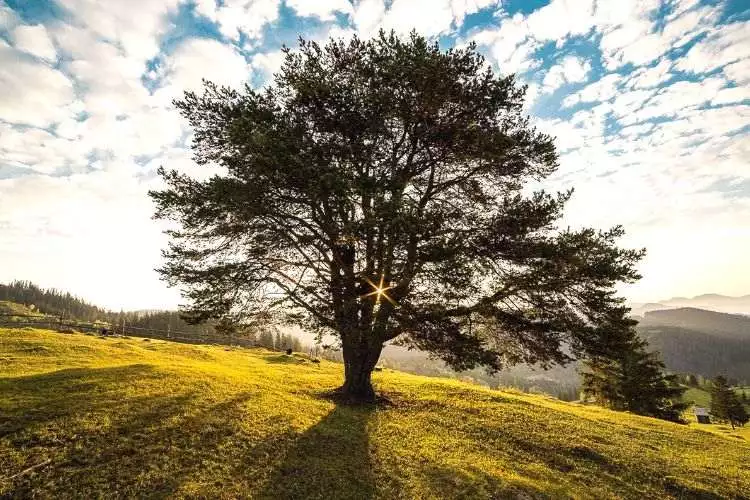
In this article, we’ll go through all the common causes, symptoms, and cures to help bring a dying oak back to life. Sound good? Let’s go!
Table of Contents
Common causes of oak tree decline
Given that we have little control over the health of oak trees in their natural habitat, it’s generally the external, environmental factors that can affect their decline.
When growing them in the home, they are slightly easier to manage. Let’s look at the common causes that can damage and slowly kill an oak tree.
Soil compaction
The average oak tree can grow to a whopping 50-70 ft (15-21 m); some species can even reach heights of 100 ft (30m). The taller they get, the stronger their root systems need to anchor that amount of weight.
Therefore, these types of trees require loose soil to allow both air and moisture access to the root system. If the soil of an oak tree is too compact, the tree will present smaller, yellowish leaves, and the overall growth will slow down. It will also die back.
Poor drainage
Alongside being grown in compacted soil, inadequate drainage is one of the biggest reasons an oak tree will suffer. When a tree of this stature is grown in a soil or container that doesn’t allow drainage, the root system sits in stagnant water.
As the roots are surrounded by water, they are essentially suffocated and denied vital oxygen and the ability to respire.
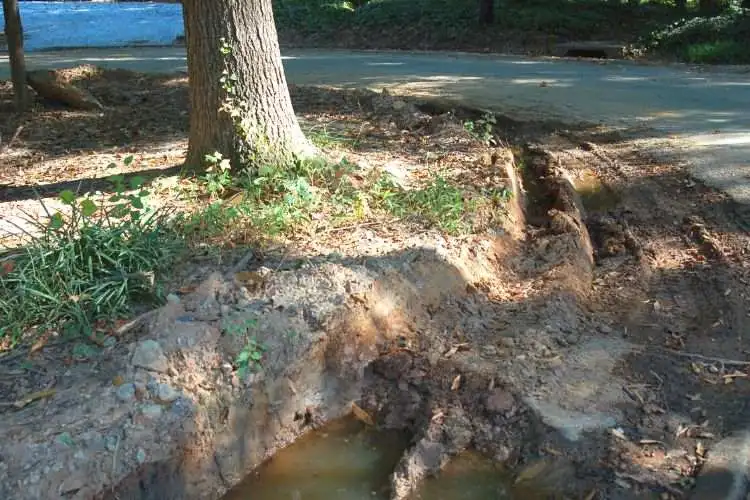
As this occurs, the roots don’t have the strength to grow, spread and form a strong anchor for the tree. As a result, the tree will grow undersized and discolored, the leaves may drop prematurely, the branches may die back, and all these symptoms can lead to eventual tree death.
Over-watering or under-watering
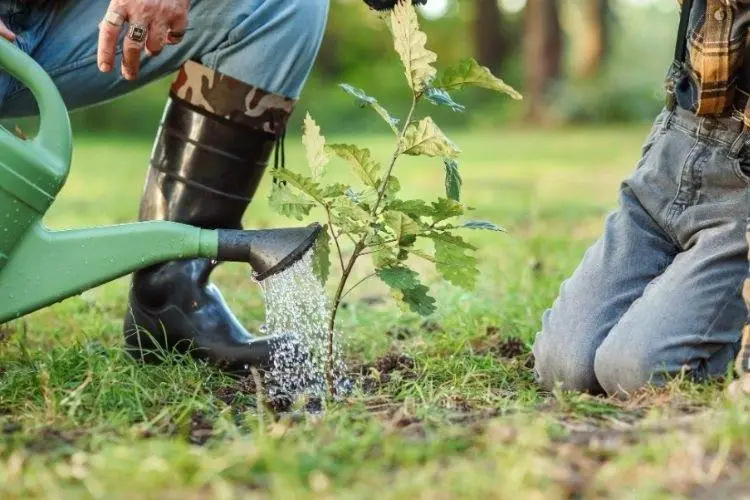
Overwatering
Overwatering an oak tree can cause an extremely fast decline. Even a healthy oak tree can die in as little as two weeks when exposed to more water than it requires. They can suffer from a condition known as (SOD) Sudden Oak Death.
This disease causes a water-borne mold pathogen to grow on and inside the bark and leaves of oak trees. The downside to this condition is that it has no known cure. Overwatering can be amplified by poorly prepared soil that offers no drainage or aeration due to compaction.
Underwatering
An underwatered oak tree will not only dry out, but its growth will slowly stunt as the nutrients it receives have no water to assist them in becoming soluble.
An underwatered oak tree will present signs of wilting, curling leaves that may turn brown at the tips and edges. Their canopy will also shrink in size and become discolored before dropping off. If the problem is left unattended, the tree will slowly die.
Lack of sunlight
A lack of sunlight will disallow an oak tree to photosynthesize at the scale they are designed. Oak trees thrive best in open fields where they can bask in the full, unhindered sun all day.
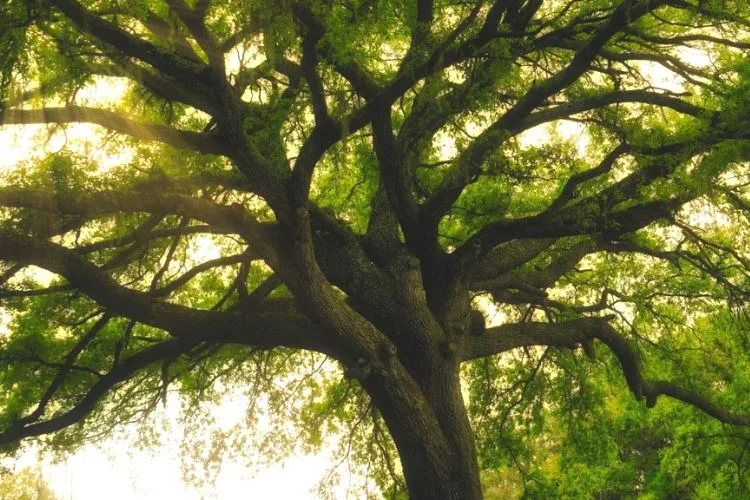
They struggle to grow in areas where they are covered by shade. They may become stunted or grow disproportionate when denied access to the sun. As a result, they will slowly die.
Pests & Diseases
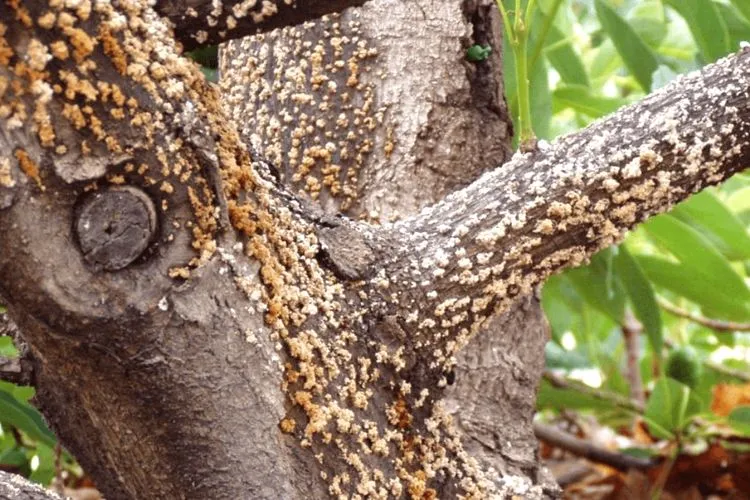
Pests
The most common pests to attack oak trees include Forest tent caterpillars, gypsy moths, Oak leaftiers, Oak leafrollers, and Scarlet oak sawflies. These pests feed on the oak leaves and bark while burrowing into branches and trunks to make themselves at home.
Mature trees can generally withstand smaller attacks. However, newer, more tender trees will suffer from the mess they can make while destroying any limb they get their mouths on.
Diseases
The most common diseases most oak tree species can contract to include Anthracnose, Sudden Oak Death, Oak tatters, and Oak wilt. All 4 are certain types of fungal diseases caused by excess water around the roots, high humidity, and even via pests.
SOD is a silent killer that can take down a healthy tree in as little as 2 weeks. The other 3 work much slower, but if left undiscovered and untreated, the tree will endure a long, slow death.
Root damage
Several underlying issues can cause root damage. These include overwatering, poor soil preparation, and inadequate drainage. The roots become suffocated by the surrounding water and are denied oxygen.
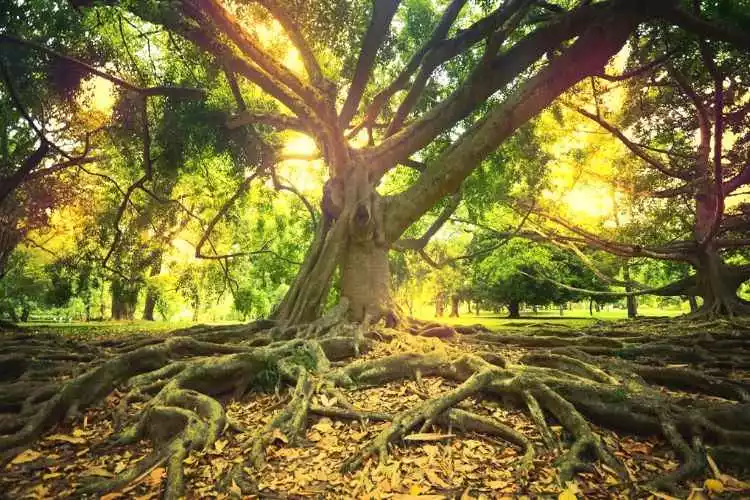
Without oxygen and the space to respire, the plant will slowly die from suffocation and the roots rotting in the stagnant water. Root damage can also be caused by certain wood-decaying fungal pathogens depending on the area that the oak is growing.
Environmental factors
The weather is the most common environmental factor that can cause life-threatening damage to an oak tree. Depending on the stage of the oak’s growth, weather conditions such as extreme heat and chills can really cause some damage in their earlier stages, especially when they are still trying to establish and anchor themselves correctly.
The heat can scorch the tree and dry them out, leaving them dehydrated and unable to grow. Frost and snow can freeze up the water stores of an oak tree but also turn the tender limbs into mush if not protected.
Then there can be flooding, drought, and extreme winds from storms that can also cause oak trees to show signs of stress.
Symptoms of a dying oak tree
When an oak tree or any growing organism is under any kind of stress, it will present us with distinct symptoms. These symptoms can be studied and used as a tool to assist them in recovery.
The most common symptoms of a dying oak include the following.
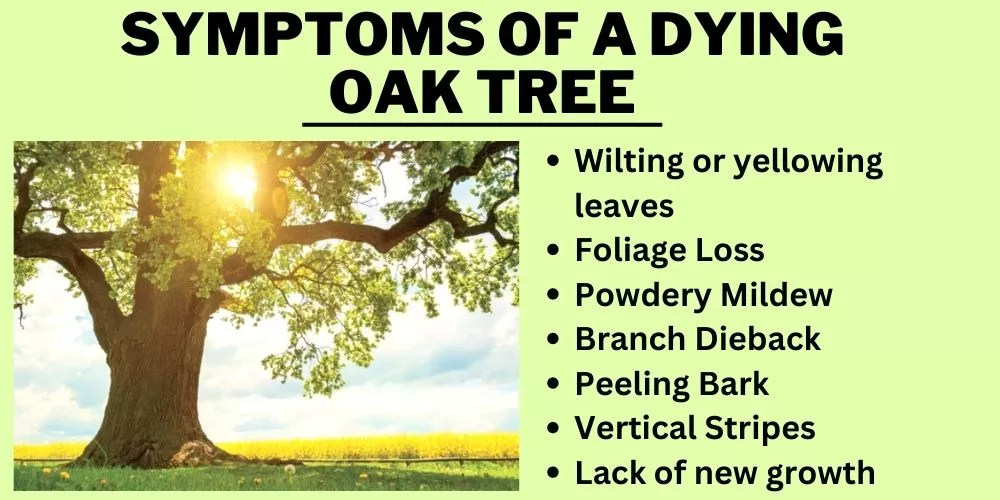
Wilting or yellowing leaves
Yellowing leaves can form via a condition known as chlorosis which is when the tree lacks chlorophyll (the pigment which makes leaves green). There are several reasons why this can occur. Namely a lack of available nutrients, which can often be attributed to underwatering.
A lack of water can also dry the tree out and cause wilting. Oak wilt, a systemic fungal disease, can also cause leaf veins, particularly, to turn yellow.
Foliage Loss
Oak trees can lose their leaves when suffering from diseases such as Oak Wilt. Oak Wilt is a debilitating disease that disrupts a tree’s xylem-producing and conducting function. This is what controls where water is distributed throughout the tree.
When this system is thrown out of whack, the tree can be denied water and slowly dry out before its leaves are dropped. Some leaves can even drop when they go through seasonal changes, although there’s generally little reason for concern during these times.
Powdery Mildew
If untreated, powdery mildew can bring down a mature tree with little effort. Additionally, the decline can happen in a very short period. This fungus can cause odd growths in the branch tips and almost velvet-like growths on the leaves.
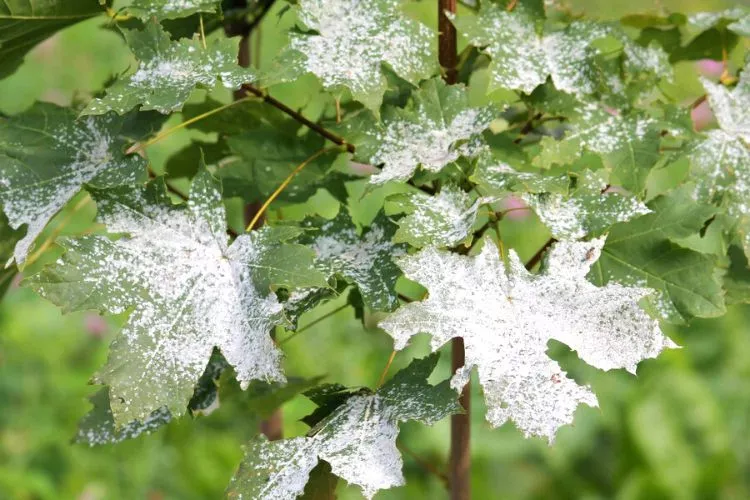
As the fungus sets in, it’s very difficult to control. Luckily it’s easy to spot, so treating it early will give the tree a better chance of survival. Powdery Mildew can be identified by a white, powdery substance forming on the leaves. It almost looks like the leaves are covered in baking flour.
Branch dieback
Branch dieback is a fungus that attacks mainly through open limb wounds that target and kill the tree’s branches’ sapwood, cambium, and phloem. The leaves slow down in growth and become pale green to yellow.
Peeling Bark
Peeling bark is usually caused by weather stress, such as drought and lack of water. The obvious signs are when the bark peels off in certain areas. They can be smaller, shorter slithers or deep, long slithers that almost look sunken. The bark can be dry and cracked and moist and rotting, making it easier to fall off.
Vertical Stripes
Vertical stripes are a common occurrence in trees. It only becomes an issue when there is an excess of slime flux. This oozing slime will form cracks on the outer areas of the bark that show up in vertical lines or stripes.
Lack of new growth
As a symptom, a lack of new growth comes in the form of branches and leaves drying out and dying, and no new limbs forming. This can be due to a range of problems, such as a lack of nutrients, inadequate sunlight, excess or a lack of water, extreme weather conditions, etc.
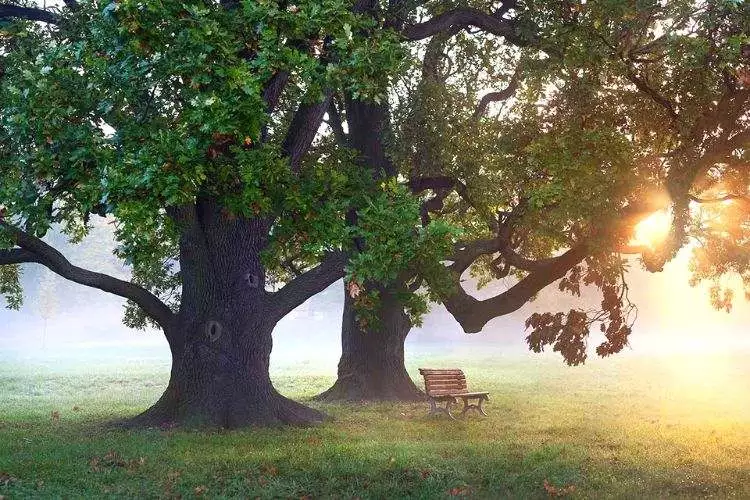
The growth will not form when the tree is trying to survive any other stress it may be suffering from. It will not try to push out any new growth until it can heal itself from the existing stress.
Steps to Assess the Situation Correctly
If you notice that your oak tree(s) are showing any kind of stress, it’s best to act fast. The last thing you want is for one of the most important trees to suffer unnecessarily. Here are some steps you can follow to assess whether or not they need any kind of help to revive.
Determine the extent of the problem
The first step should be a well-conducted visual. Take a wide walk around the perimeter of the tree. Have a look at every single part from root to top.
- Look for any abnormalities in the way that it is growing (including discoloration of leaves, peeling bark, wilting, drooping, shedding of foliage, etc.)
- Take notice of how the tree is standing regarding whether it has any kind of lean. This type of behavior could mean that the ground is unstable.
- Look into the condition of the soil that it is growing in. It may be flooded or muddy, which could cause further issues.
- Look at any surrounding growth and use them as an indicator of the overall health of the growing area.
Check for signs of pests or diseases
Pests will usually feed on both the leaves and bark. They will also burrow into branches and trunks as they make themselves at home. The pests that attack oak trees are generally large enough to spot and pry away if you have access to them.
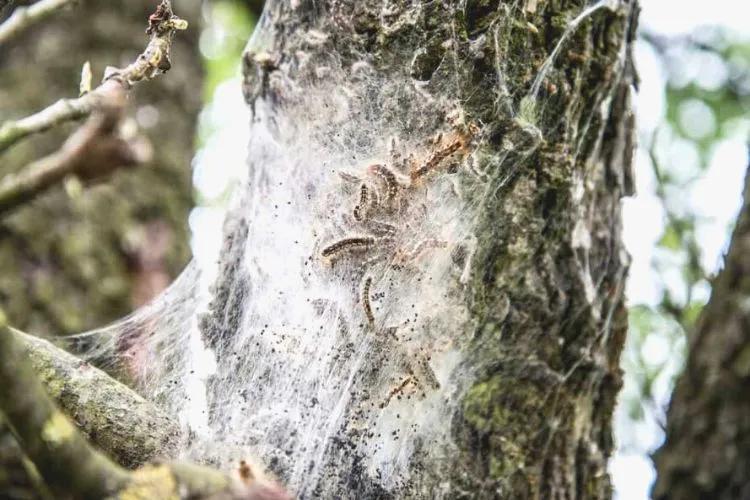
Diseases can be distinguished by the discoloration of leaves and the rotting and/or stinking of the roots and surrounding areas. You may even spot a white, powdery substance on the leaves that determines that the tree has a mildew problem.
Consult with a professional arborist
Finally, contact an arborist or tree doctor and discuss the tree issues you have with them. They will be able to determine whether or not the tree can be saved.
Often, they can remove a limb or two, and the tree will flourish and thrive even better. Sadly, some trees cannot be saved, but that’s for an expert to decide. In general, as long as signs of new growth form, there is hope.
How to Save a Dying Oak Tree?
Now that we have gone through the symptoms, it’s time to look into some actionable steps that can be taken to save a dying oak tree.
Soil Management
Soil management is usually the first aspect that needs to be examined. The soil helps the tree anchor itself and obtain nutrients, so getting this part right will set it up for a long, healthy future. Let’s look at what needs to be amended to ensure the oak trees’ survival.
Improving Soil Quality
Oak trees won’t have a problem growing as long as they have a good quality growing medium. They love materials that have adequate drainage and aeration. Growing in something as compact as clay, they struggle to anchor their roots.
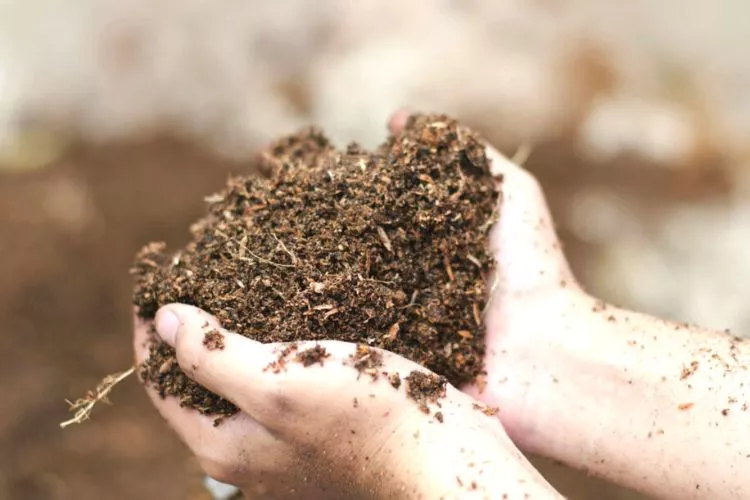
Therefore, improving the characteristics of the clay with materials such as organic compost, pine bark, composted leaves, and gypsum can help. Avoid sand or peat moss, as these materials will only clog the soil up.
Providing Proper Drainage
You can approach drainage issues to an established oak tree in several ways. You can amend the soil with the materials mentioned above. This can be done by slowly working them into the top layer, and the characteristics can change dramatically over time. You can also dig sloping drainage trenches away from the tree.
This is a delicate job as you want to avoid disturbing the root system. It’s best to use a thin spade or pick to spore out a channel and add some drainage rock before filling the trench. If you redirect any top pooling water, the tree will have a much better chance of staying healthy.
Mulching
Mulching is a great method of water retention in areas where trees don’t have access to abundant water. Simply adding a 2-3 inch layer of good quality mulch around the base of the tree will help to keep the soil moist without becoming muddy.
Mulch is also great in the warmer seasons, where it holds the moisture down and creates a barrier that extreme heat cannot penetrate.
Watering and Irrigation
Proper watering and irrigation methods are essential to the survival of oak trees. They like to be watered but not waterlogged, especially around the roots.
Water is vital for delivering nutrients to the roots and helping with photosynthesis. The larger they grow, the more they utilize this process, meaning the water volume needs to be scaled.

Proper watering techniques
Fully established, mature oak trees must be watered 2-3 times per week. Some larger trees can soak in as much as 50-100 gallons (190-380 liters) of water per day. However, the frequency and amount are more determined by various environmental conditions.
These include climate, soil characteristics, exposure to sunlight, etc. Oak trees are considered drought tolerant but still require some kind of moisture during the warmer months to prevent them from drying out.
It’s recommended to ensure that the soil gets a good deep watering and is left to completely dry out before administering any more. Always check the condition of the soil before each water so that you’re not overdoing it.
Avoiding over-watering or under-watering
Overwatering is a huge no-no when it comes to oak trees. The roots are susceptible to certain wood-decaying fungal pathogens that show up when excess moisture is present. In contrast, when an oak tree doesn’t receive adequate water, it will struggle to grow by not being able to transform any nutrients into a soluble form.
Fertilizing
When grown in their natural environment, healthy, mature oak trees don’t require any form of supplementary fertilization.
They have the luxury of being fed utilizing leaf litter and other organic debris that decomposes and releases into the soil and roots. Quite often, it’s their organic matter that feeds them!

Understanding the needs of oak trees
As mentioned, mature oak trees don’t generally require any fertilization. Supplying them with supplementary food can cause problems such as burning and discoloration of the leaves.
On the other hand, choosing the right fertilizer for a newly established or younger tree needs to be done carefully.
The main concern is the nutrient value already present in the soil. Adding any extra on top of existing nutrients can lead to disaster. For example, using a fertilizer with a high nitrogen content can bring on overgrowth of branches and leaves, attracting pests and diseases. This is something that should be avoided.
Choosing the right fertilizer
In the early stages of an oak tree’s growth, they require an NPK ratio of around 12-4-8 (12% Nitrogen, 4% Phosphorus, and 8% Potassium). Even a 12-6-6 mix will provide all the essentials required.
It’s always recommended to test the blend on the tree in a half dose before fully administering it to ensure it can handle the ratio before continuing.
Pest and Disease Management
The majority of pests that can cause any kind of issues for oak trees are large enough to be able to be picked off and discarded. However, larger, more mature trees make accessing them much more difficult.
Diseases, on the other hand, require a trained eye and a little extra knowledge to spot and distinguish. Let’s look at how to identify and treat both pests and diseases.
Identifying pests and diseases
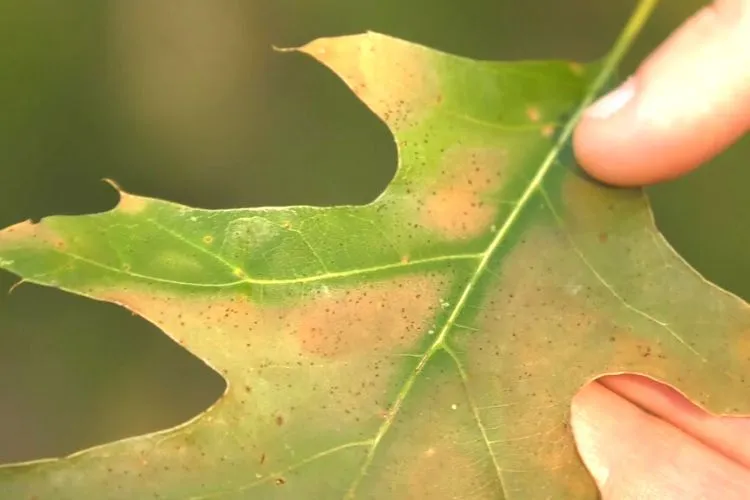
Pests:
- Forest tent caterpillars – These little guys have a turquoise-lined back with pale yellow spots. They are known to build pad-like ‘homes’ on branches and trunks. If anything, their presence invites other pests that can cause further damage. Otherwise, they make lunch of the foliage.
- Gypsy moths – These are mustard-brown colored moths. They defoliate, weaken and kill many tree species from leaf to branch to trunk.
- Oak leaftiers – Another moth species with mustard color and rounded brown shapes in the middle of their wings. They consume the leaves, leaving nothing left.
- Oak leafrollers – These fluorescent yellowish-green caterpillars defoliate and leave the tree bare.
- Scarlet oak sawflies – These little guys are a little harder to spot. They are translucent green and yellow worm-like insects that feed on the lower portion of the leaf and the inside of the leaf veins.
Diseases:
- Anthracnose – Caused by a fungal pathogen. Its tan can identify me with dark brown spots on the mature leaves of the lower and inner branches.
- Sudden Oak Death – Cankers on the trunk are often caused by almost incurable overwatering.
- Oak tatters – This disease is known to be brought on by herbicide drift and cold injury, or a combination of both. The leaves become shredded and look lacy
- Oak wilt is another fungus in the tree’s water conducting system. You will notice brown streaks in the wood beneath the bark, and the branches become limp and weak.
Treating pests and diseases
Pests:
Some larger pests can be picked off by hand or brushed off with a stick and discarded. Otherwise, using a natural pesticide like Neem Oil can usually take out the more intricate species.
We recommend using natural products as much as possible. However, they are not always available. If you need to go down the line of chemical products, then spinosad, permethrin, cyfluthrin, cyhalothrin, bifenthrin, or acephate are all great for eradicating and preventing pests on oak trees.
Diseases:
As mentioned, we try to use natural products where possible, even when applying them to diseases. We have had the best success with products that include and are not limited to copper, baking powder, tea tree oil, sulfur, and neem oil.
Each of them has a separate method of use. They usually involve creating a solution and spraying them on the affected area.
Sunlight Exposure
Oak trees want and need sunlight. They love nothing more than being out in an open field, soaking up as many rays as possible. Denying their precious vitamin D will slowly kill them off.
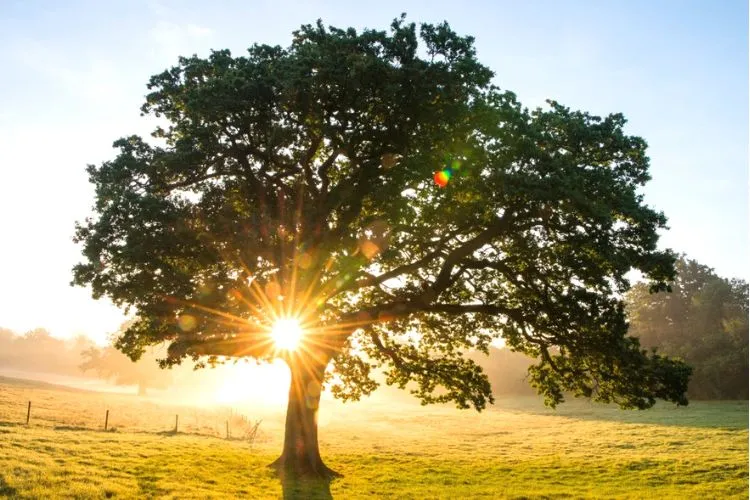
Ensuring adequate sunlight
The only way to ensure that an oak tree receives adequate sunlight is by simply planning and planting them somewhere where it can access the sun. Once planted, they have been documented as growing for up to 1000 years, so it’s hard to move them once set in place.
Furthermore, they aren’t the type of plant you can fit in a growing container. If they are growing somewhere, that isn’t receiving ample sunlight; you may need to assess whether you can either remove some shading foliage or anything else that is blocking them.
Pruning
Lastly, pruning an oak tree may be the hail mary required to keep it alive. Some oak trees can be so worn out from pests and diseases on a particular limb that simply removing the limb can add new life to them.
Furthermore, they may just have areas where once removed; the tree can focus its energy on new growth and revival.
When to prune?
Pruning should always be part of any tree’s maintenance routine. We recommended doing a spot check every 3-6 months to see whether or not any branches or limbs need to be cut back or removed.
As brutal as it sounds, this process encourages new growth. If you notice any damage caused by pests, disease, weather, or anything else, then it’s always a good idea to take action as soon as possible.
Importance of proper pruning techniques
When it comes to pruning the tree, you can take a couple of paths. You can use a qualified specialist such as an arborist or do the work yourself. If you take matters into your own hands, try to make clean straight cuts wherever possible. Jagged, uneven limbs are an open invitation for pests and/or diseases.
A Few Additional Pro Tips
Let’s round off with some final pro tips on saving and maintaining a dying oak tree.
Proper tree selection tips
When planning to plant an oak tree, it’s extremely important to choose one suited to the growing area. Some oak trees only tolerate certain soil types, some require more sun than others, and some may even thrive in a specific climate.
These details should be ascertained before planting because once they’re in the ground, it’s not uncommon for them to last over 1000 years.
Regular tree maintenance
Regular tree maintenance is a must. Especially if you’re trying to train them to grow in a particular way or shape, we recommend that all trees that have the potential to grow quite large should be checked for any issues once every 3-6 months.
This includes damage from pests, any forming disease, or a freshen-up from decaying or damaged branches.
Adequate sunlight and space
We cannot stress how much oak trees love being pounded with Vitamin D daily. Make sure to do a lot of planning before planting them in the ground and ensure their rays aren’t blocked by anything. This may include other trees, hills, structures, etc. Keep them out in the open if possible.
Frequently Asked Questions (FAQs)
What is the best fertilizer for oak trees?
A young oak requires a fertilizer with a ratio of either 12-4-8 (12% Nitrogen, 4% Phosphorus, and 8% Potassium) or 12-6-6. However, once they mature, they don’t require any supplementary plant food. They receive all their nutrients from fallen leaves and ground matter that decomposes and is absorbed into the soil and roots.
Should you water oak trees in a drought?
Oak trees need a deep, slow drink of water during a drought. Water not only replenishes a tree’s moisture but also helps to break down any nutrients absorbed into the soil and roots once decomposed. In simple terms, it makes the nutrients more soluble.
Can I cut down a dead tree on my property?
Dead trees can be a safety risk regardless of where they are. It’s usually ok to cut one down if it’s on your property; however, it’s always recommended to check with your local council to ensure that it is within the law to do so.
Conclusion:
Oak trees are extremely important for a lot of wildlife as well as within woodworking industries. Keeping them alive and healthy is a role we need to take responsibility for as caring humans.
It’s usually pretty easy to spot a dying oak tree. The leaves may be fading, wilting, and dropping off.
The limbs may have been destroyed by pests or hanging by a thread from unfavorable weather. Whatever the case, the best way to ensure that an oak tree doesn’t die is by doing regular maintenance checks.
We hope that this guide has been helpful. You can read about similar topics here on our website. Check back again soon for more.


